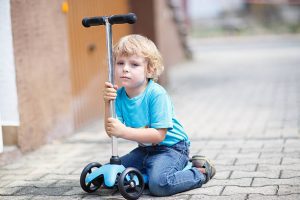Looking for scooter safety tips for indoor rides? We’ve all seen the joy on a child’s face when they’re zipping around, but did you know that scooters can be just as fun indoors too? Riding can definitely be fun, especially when there are other kids around.
We understand the importance of having a safe and enjoyable experience inside the house. That’s why we’re here to guide you through the process of making scootering a fun activity for your little ones.
We’ll cover everything from picking the right scooter and for preparing your home environment to teaching basic skills and enforcing protective rules.

We’ll also discuss the importance of supervising your children, limiting speeds, establishing designated areas, and maintaining their scooters regularly.
Our goal is to make sure that you’re fully equipped to provide a safe and enjoyable experience for your kid. So, let’s dive right in and learn how to make indoor rides just as fun as outdoor adventures but with the added comfort of being inside your home.
Additionally, be sure to follow relevant regulations, follow guidelines from the Consumer Product Safety Commission, and use helmets, pads, and other protective gears.
Key Takeaways
- Choose the right scooter and prepare the indoor environment for a fun and protected experience.
- Learn basic skills and enforce rules on protection, including the use of helmets and speed control.
- Supervise your children and set boundaries to prevent accidents.
- Regularly maintain their scooter, including checking tire pressure and ensuring smooth brake function, to prioritize protection.
Understand The Basics Of Indoor Scootering
Before your child starts zooming around the house, they’ve got to get the hang of the basics of scootering. It’s essential to understand that indoor scootering presents unique challenges, like maneuvering around obstacles in the house, which can be quite different from outdoors. So, be patient and let your child practice their turns, stops, and speed control.
Customization can increase control, comfort, and protection, so consider adjusting handlebars or wheels to better suit your indoor space.
Remember, the goal is to provide a thrilling yet protected experience, so it’s important for your child to respect household boundaries and stay aware of the surroundings.
Choose the Right Scooter
Picking the perfect two-wheeler isn’t just about style or speed, it’s also about matching your unique needs and environment. Choosing isn’t just a matter of preference, it’s crucial for protection too.
- Customization: Don’t shy away from customizing. Choose handlebars, wheels, and brakes that cater to home riding style.
- Age-appropriate selection: Kids and adults have different needs. Make sure to select a scooter that’s suitable for the user’s age and experience level.
- Understand the terrain: Indoor surfaces can be slippery. Select non-marking wheels to prevent skids and scratches.
- Comfort and ergonomics: Ensure the scooter is comfortable and easy to handle, especially when maneuvering around tight corners.

Prepare The Environment
Imagine transforming your living space into a thrilling track where your child can practice their skills without causing any harm or damage. Careful consideration must be given to furniture arrangement and lighting conditions.
Prioritize rearranging furniture to create a clear, obstacle-free path to minimize the risk of accidents. We also suggest securing any loose rugs or mats that could cause slips or trips.
Lighting considerations are crucial too. Aim for a bright but diffused light to prevent glare or shadows that might impair visibility.
Ensuring the environment is prepared is a way of serving the protection of all participants.
Teach Basic Skills
Once your living space has been transformed into a scooter-friendly zone, it’s time to equip yourself with some essential skills to really get the most out of your thrilling tracks.
- The first thing to master is balancing techniques. This is crucial for maintaining control while navigating through your indoor track.
- Secondly, the importance of foot placement can’t be overstated. Your child’s feet should be positioned correctly on the deck for maximum stability.
- Thirdly, make sure your child is comfortable turning and stopping, and practice these maneuvers until they become second nature.
- Lastly, always stay attentive to their surroundings, even when they’re having so much fun.
By fostering these skills, your child will be ready to glide around your home safely.
Enforce Safety Rules
While flying through your homemade raceway is a blast, it’s crucial your child doesn’t forget to buckle down on some vital rules to keep every adrenaline-filled run incident-free. Implementing signage around your indoor course will help remind everyone involved about the importance of protection.
Post signs that highlight the need for a helmet warn about possible hazards or remind them to keep their speed under control.
Riding an electric scooter indoors or outdoors requires safety measures, and wearing a helmet is one of the most basic of them to prevent head injuries. Safety is intentional, and scooter rides are fun, but scooter riders also have to be safe while enjoying the sport.
A pivotal parental role is to enforce these rules consistently. It’s your duty to ensure rules are treated with seriousness and not merely seen as suggestions. This way, you cultivate a fun yet protected environment for your little ones.
Use Protective Gear
Let’s not forget the importance of using protective gears at all times.
A child can be prone to a lot of injuries, such as head injuries, when on a kick scooter. To prevent accidents or injury or skull fractures caused by injuries, your kid must wear a helmet that fits properly. This prevents skull fractures.
Teach your young child to wear protective equipment at all times. Moreover, they can easily lose control when indoors, so teach and supervise them. They can learn easily when being supervised by their parents.
Helmets, knee, and elbow pads are essential pieces that shouldn’t be overlooked. These items play a significant role in protecting your little ones from potential injuries.
Helmets
Don’t forget, your child has to pop on a helmet before they start zipping around the house – it’s not just about looking cool, it’s about keeping protected!
Now, let’s talk about helmet designs and helmet fit.
- Helmet designs come in a variety of shapes and colors, so choose one that appeals to you while satisfying protection standards.
- A proper helmet fit is crucial. It should sit level on the head and not rock side to side.
- The helmet strap should be snug but not too tight. It should form a V shape under and slightly in front of the ears.
- Check the helmet’s size and adjustability. Most have an adjustable ring inside for a better fit.

Knee And Elbow Pads
Guess what? Knee and elbow pads are your child’s best buddies when it comes to battling those unexpected tumbles! These protective gears ensure that they have fun while keeping those crucial joints protected.
When it comes to pad selection, don’t rush. Take your time to find the right fit. An ill-fitting pad can do more harm than good. Always remember, the comfort factor is equally important as protection. Your child should be able to move freely without discomfort while wearing them.
We can’t stress enough how vital these pads are in preventing scrapes and bruises. But remember, while they provide a level of protection, they’re not magical.
Supervise Your Kids
You’ll want to keep a close eye on your little one, ensuring their ride is both fun and protected, so parental involvement is crucial. We know it can be a bit daunting, but don’t worry – we’re here to help!
- Setting Boundaries: Teach your child to respect home furniture and decor. Instill the importance of not bumping into things or people.
- Child training. This is key here; explain the reasons behind the rules.
- Practice Makes Perfect: Encourage your child to practice indoor scootering in a protected, open space.
- Be Present: Your involvement doesn’t end with setting rules. Stay nearby to supervise and guide.
Let’s not forget about the need to limit speeds, another significant factor.
Limit Speeds
It’s absolutely essential to keep a check on how fast your little one is zipping around, and speed control is critical. We can’t stress enough the importance of teaching kids to control their speed, especially while taking turns.
Turning techniques can be tricky, but mastering them can significantly reduce the chances of accidents. Encourage your child to slow down before turning and gently lean into the turn. This can prevent them from getting off-balance, which is a common cause of accidents.
Remember, a fun ride doesn’t equate to being fast. It’s about the freedom to explore and play in a controlled manner.
Establish Designated Scootering Areas
Imagine the sense of relief you’d feel knowing there are specific zones in your home where your child can freely and safely zip around. Establishing designated areas is a crucial protective measure that you can’t overlook.
Use items like rugs, furniture, or even colored tape to mark these area boundaries. This not only provides a protected space for your kids to ride but also helps them understand the concept of traffic flow.
Consider places with less foot traffic and avoid areas near stairs or sharp corners. Additionally, ensure these zones are clear of small objects that could cause accidents.
By designating these areas, you’re promoting protection in their home play.
Make Regular Scooter Maintenance A Priority
Regular maintenance isn’t just about keeping your child’s set of wheels looking shiny and new; it’s a crucial step in preventing mishaps and accidents.

We can’t stress enough the importance of checking tire pressure regularly. An underinflated tire can make the scooter harder to control, increasing the risk of accidents.
A brake check is equally essential. Ensure that the brake functions smoothly, stopping the scooter promptly when applied. A faulty brake system can cause grave accidents, particularly in settings where space is limited.
In essence, you’re not just maintaining a scooter, you’re protecting your children’s well-being. So, commit to regular upkeep, prioritizing tire pressure checks and brake inspections.
Conclusion
We’ve shared some key insights on ensuring a fun and safe indoor scootering experience – a topic that FamilyHype has become a thought leader.
It’s vital to choose the right scooter, prep the environment, and teach essential skills, such as balance, agility, and protection. Always enforce rules on protection, supervise the activity, limit speeds, and keep riding zones clear. Don’t forget regular maintenance, either. It’s just like having a bike or car as well.
We hope that this guide has given you the tools to create a safe and enjoyable experience for your child.
Frequently Asked Questions (FAQs)
What Are The Safety Concerns Of Scooters?
Some common concerns include:
- Balance and stability: Scooters require good balance and coordination to ride safely, and riders may be at risk of losing balance and falling.
- Visibility: Scooters are smaller and less visible than cars, so it’s important to ensure other road users can see you.
- Road conditions: Uneven surfaces, potholes, or slippery roads can pose risks.
- Traffic and pedestrians: Sharing the road with other vehicles and pedestrians requires caution and awareness.
How Can You Be Safe On A Scooter?
Consider the following tips:
- Wear a helmet or protective gear: Always wear a helmet, as well as other protective gear such as knee and elbow pads, gloves, and sturdy footwear.
- Follow traffic rules: Obey traffic laws, including speed limits, stop signs, and traffic signals.
- Be visible: Use reflectors, wear bright clothing, and use lights at night to make yourself more visible to other road users.
- Stay alert: Keep your focus on the road, be aware of your surroundings, and anticipate potential hazards.
- Practice defensive riding: Assume other drivers may not see you and be prepared to react to unexpected situations.
- Maintain your scooter: Regularly check your scooter’s brakes, lights, and tires to ensure they are in good working condition.
- Don’t use scooters with large cracks. While scooting can be a great exercise, child safety should still be a priority.
What Is The Safest Scooter?
Considering factors such as safety features, build quality, stability, and user reviews, some scooters are known for their safety features. These include those equipped with advanced braking systems, good stability control, and robust construction. When considering the safety of electric scooters, it’s advisable to research specific scooter models, check for safety certifications, and read user reviews to gauge their performance.
Which Is Safer, A Scooter Or A Bicycle?
The safety of scooters versus bicycles can vary based on factors such as riding an electric scooter or bicycle in varied conditions and the individual behavior of the rider. Bicycles generally offer more stability due to their design and broader tires. In contrast, electric scooters might require more balance and skill for a safe ride, especially in busy bike lanes. Regardless of your mode of transportation, prioritizing safety precautions, like wearing protective gear and adhering to traffic rules, is crucial.
What Is A Safe Speed On A Scooter?
This can vary depending on several factors, including road conditions, traffic, and the specific electric scooter model. It is important to adhere to speed limits and adjust your speed according to your surroundings. Moreover, it is good to stay on the sidewalks than on the road when scooting. As a general guideline, it is recommended to ride at a speed that allows you to maintain control, react to unexpected situations, and ensure the protection of yourself and others.
Are Manual Scooters Safe?
Yes, provided proper precautions are taken. However, they require good balance, coordination, and skill to operate safely. It is important to familiarize yourself with the scooter’s controls, practice riding in a protected area, and gradually increase your skill level. Always wear protective gear and follow guidelines to minimize the risk of accidents.
Which Scooter Has The Best Ride Quality?
The scooter with the best ride quality can vary depending on individual preferences and requirements. Some factors that contribute to a good ride quality include suspension system, seat comfort, and overall stability. It is recommended to test ride different scooter models and consider user reviews to determine which scooter provides the most comfortable and smooth riding experience for you.
Are 4-Wheel Scooters Safe?
Four-wheel scooters, also known as mobility scooters, are designed for individuals with mobility limitations. They offer stability and support, making them generally safe for their intended users. However, as with any vehicle, it is important to use them responsibly, follow safety guidelines, and be aware of your surroundings to ensure safety.
What Is The Best Age For A Scooter?
The best age for riding a scooter can vary depending on local laws and regulations. In general, many places allow teenagers and adults to ride scooters legally. However, it is important to consider the individual’s physical and cognitive abilities, as well as their maturity level and understanding of traffic rules and protection precautions. It is advisable to check local laws and regulations to determine the minimum age requirements for riding a scooter in your area.
How Can You Prevent A Scooter Accident?
- To prevent scooter accidents, consider the following measures:
- Wear protective gear, including a helmet, knee and elbow pads, gloves, and sturdy footwear.
- Follow traffic rules and regulations, including speed limits and traffic signals.
- Be alert and aware of your surroundings, anticipating potential hazards.
- Maintain your scooter in good working condition, regularly checking brakes, lights, and tires.
- Avoid distractions, such as using your phone or listening to music while riding.
- Practice defensive riding, assuming other drivers may not see you, and be prepared to react to unexpected situations.
- Take riding courses or training to improve your skills and knowledge of scooter protection.
